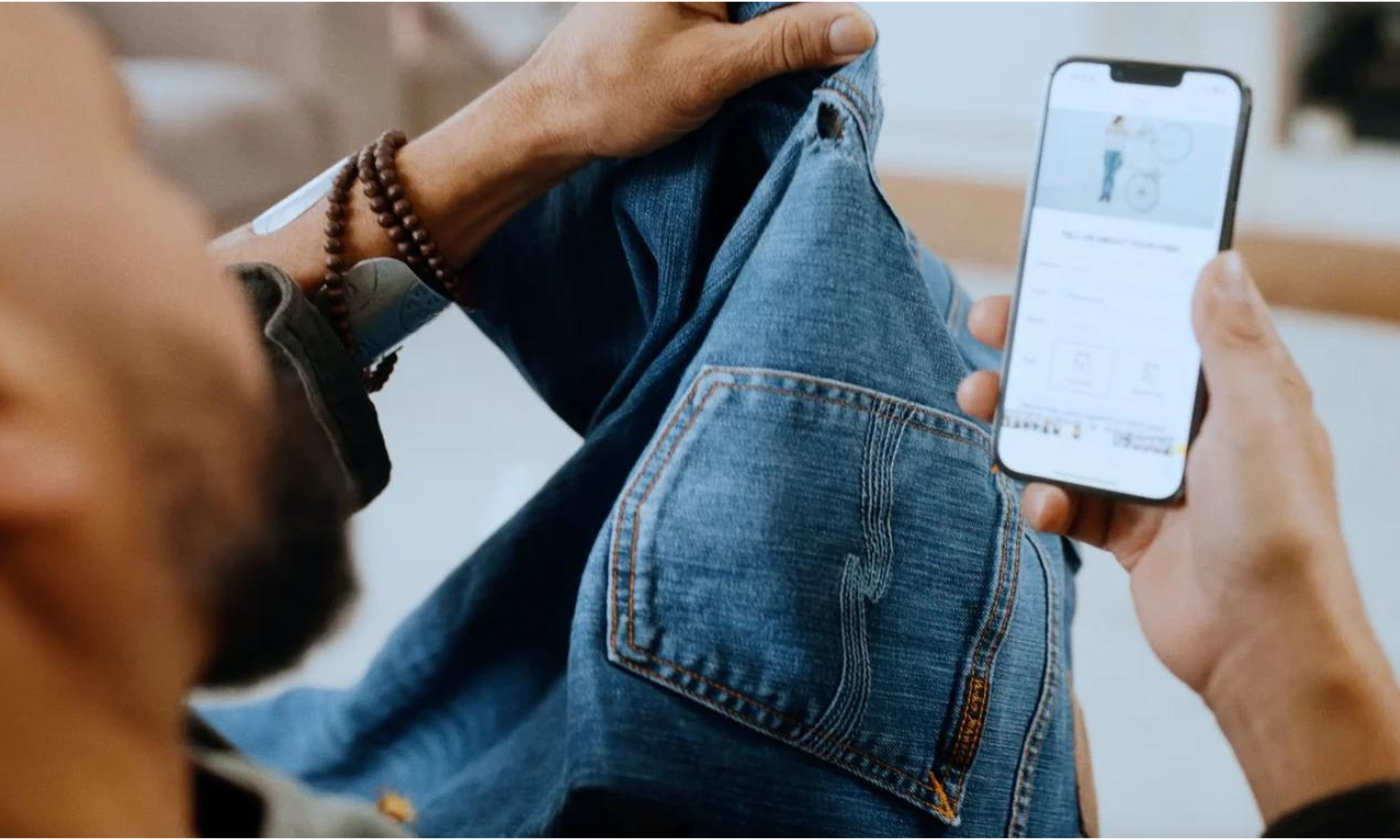Witnessing fashion brands embrace repair services sparks interest among other brands on integrating similar offerings. The question arises: What's the optimal approach? While some offer free repairs, others set constraints on eligible repair types or propose cost-sharing with their customers. This article delves into diverse strategies on how to offer a repair service: for free or not for free.
1 // Brand pays 100% of the repair costs.
The brand covers all repair costs—no ifs, ands, or buts. Whether it's a factory hiccup or a tear from everyday wear, the brand foots the bill. Nudie Jeans, is an example of a company offering it this way. It reflects a top-notch service level and a pledge to durability. Yet, there's a catch; the risk of people exploiting the service is there, given the easy 'let's give it a shot' vibe. Nonetheless, it's an intriguing proposition. Picture having a car, driving it for two years, accumulating scratches from regular use and your driving habits, and the garage fixing it all for free. That would be quite uncommon, while in the fashion industry that is not necessarily the case.
Some brands boast about offering a free repair service, but a closer look at the terms and conditions unveils a few nuances. Take Patagonia, for example. While they advertise a free repair service, there's a one-time shipping fee buried in the details for certain situations. Repair fees are applicable to certain items, and some items aren't eligible for repairs. Additionally, they've set a limit on the number of rips an item can have to qualify for repair. We see this as a sensible decision on the brand's part and we commonly recommend our partners to instill conditions under which items are eligible for a repair.
2 // Brand pays a certain percentage of the repair costs.
An alternative approach to catering to your customer without shouldering the entire repair bill is to contribute a portion of it. A fashion brand may choose to consistently cover, let's say, 50% of the overall repair costs. For instance, if the original repair costs amount to €10, the brand covers €5, leaving the customer with a €5 payment. If the repair costs rise to €50, the brand covers €25, and the customer pays the remaining €25. The percentage a brand opts to cover can vary anywhere from 1% to 99%.
This solution offers a convenient entry point for fashion brands and retailers contemplating a repair service. While a brand can always choose to offer repairs for free, communicating a shift from free to paid services to customers can pose challenges. Doing it the other way around is more straightforward and may even feel to your customers like you do them another favor.
3 // Brand pays a fixed amount of the repair costs.
Similar to the previous option, this solution involves the brand offering compensation, but instead of a percentage, it's a fixed amount. For instance, a brand consistently reimburses €20, irrespective of the overall repair costs. Consequently, there are situations where the brand covers the entire repair expenses, and in other cases, the customer is responsible for the difference. Repairing certain items, like buttons or belt loops, tends to be more affordable compared to fixing substantial damages, such as a rip in the crotch area.
The advantage of this approach lies in its clarity for the brand regarding potential repair costs, making communication straightforward. Additionally, it provides the flexibility to transition to offering free repairs at a later stage.
4 // Brand pays only for the factory mistakes.
In this scenario, a brand covers repairs only for issues that appear to result from faulty production. Take jeans, for example; factory mistakes could involve buttons falling off, seams coming undone, or zippers malfunctioning.
Offering repairs under a self-imposed warranty period is a practical solution. However, determining an item's age and verifying whether the issues stem from factory mistakes can be challenging once the item is in hand. Additionally, customers whose items break within the initial months post-purchase might prefer a new or different item rather than opting for repairs.
Unfortunately, many brands lack a process to address these factory mistakes occurring in the early weeks or months after purchase. This gap can lead to frustrated customers (and employees) and a repair service can help solve this issue.
5 // Brand does not pay for the repairs but refers to a reliable source to fix or fit.
The brand opts not to cover repair costs but instead directs customers to a trusted source for fixing or fitting. While this approach is less common, it proves highly beneficial when a fashion brand or retailer prefers not to provide free or partially paid repair services. For customers, identifying a skilled tailor, especially for high-quality items or those made from specific materials, can be challenging. Take denim, for instance; many customers may not be familiar with terms like "chain stitch machine" or know who possesses such specialized skills and equipment. By guiding customers to a reliable, high-quality tailor, the brand builds trust and simplifies the process of getting items fixed or fitted, encouraging customers to enjoy their pieces for an extended period.
This approach is suitable for handling repairs arising from regular wear and tear by customers. However, it may not be the ideal solution for addressing issues stemming from factory mistakes, as customers experiencing such problems may prefer a direct resolution rather than seeking external repair services that they have to pay for themselves.
6 // Brand offers it as a membership benefit.
Certain brands are introducing or considering membership programs and have included (partial) free repairs as a perk for their members. This serves as an enticing incentive for customers to join the brand's membership, providing valuable marketing data and an opportunity to offer enhanced services, thereby strengthening the brand-customer relationship. Memberships may vary, with some being paid and others offered for free.
It's important to view repairs not only as a functional solution but also as an added benefit, serving as a tool to enhance customer retention and loyalty. This perspective was detailed in our previous blog, where we discussed 5 reasons for fashion brands to offer a repair service.
Which approach to providing repairs aligns with your brand?
The response depends on your customer demographics, the nature of your products, your future strategies, and the rationale behind offering a repair service. Figuring this out demands some groundwork. However, as a brand, you are not perpetually bound to a single method of offering repairs. You can seamlessly transition from partly paid to fully free and vice versa over the course of months or years.
Get It MENDED
In this blog, we've outlined how brands can provide repair services in different manners—covering 100% of the costs, a portion of it, or none at all. Alternatively, they can associate repairs with specific packages, like a membership. Beyond these approaches, there are numerous ways for brands to offer repair services to their customers. We anticipate a growing array of options in the coming years, as providing a repair service becomes non-negotiable for customers of (premium) brands. We can assist you in crafting the strategy that aligns best with your brand.
Are you keen to discover what suits your brand the most? Schedule a demo call with us and let's chat!





Leave a comment
This site is protected by reCAPTCHA and the Google Privacy Policy and Terms of Service apply.